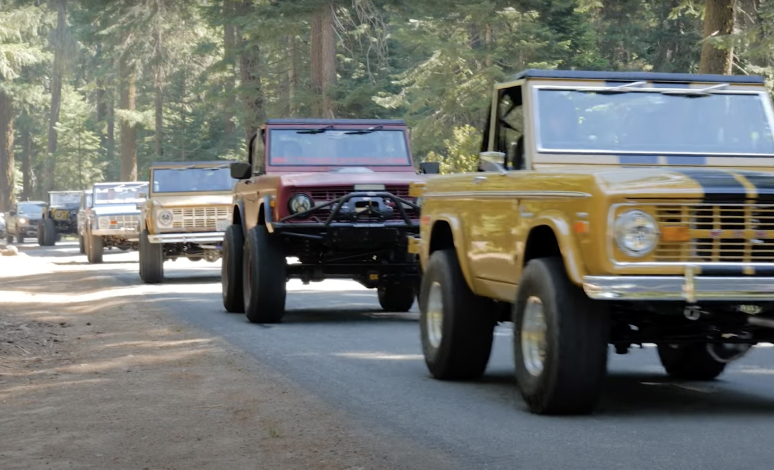66-77 Bronco C Bushing Kit Installation
Important
Installation requires a professional mechanic. Prior to beginning, inspect the vehicle’s steering, driveline and brake systems, paying close attention to the suspension link arms and bushings, anti-sway bars and bushings, tie rod ends, pitman arm, ball joints and wheel bearings. Also check the steering sector-to-frame and all suspension-to-frame attaching points for stress cracks. The overall vehicle must be in excellent working condition; repair or replace all worn parts.
Read instructions thoroughly before starting. Be sure you have all needed parts and know where they install. Read each step completely as you go.
NOTES:
- A foot-pound torque reading is given in parenthesis ( ) after each appropriate fastener.
- Do not fabricate any components to gain additional suspension height
- Prior to attaching components, be sure all mating surfaces are free of grit, grease, undercoating, etc.
- A factory service manual should be on hand for reference. We suggest the Chilton’s Repair Manual.
Instructions
PREPARE VEHICLE: Place vehicle in neutral. Raise front of vehicle with a jack and secure a jack stand beneath each frame rail, behind the radius arm frame brackets. Ease the frame down onto the stands, place transmission in low gear or “park”, and chock rear tires. Leave the jack in place so that it supports the front axle but does not lift the frame away from the jack stands.
REMOVING THE SHOCKS, COILS, & COIL CUPS: Perform the following steps one side at a time. Start on either side.
Remove lower nut and bolt from shock absorber on one side only and free the shock from the mounting. In case of a dual shock set up, remove both lower nuts/bolts.
Remove two bolts from the upper coil retaining spring clip. Lower axle with floor jack until coil is free from upper coil bracket.
Using the proper size box end wrench, remove the two lower coil seat and retainer bolts. Remove the coil.
LOWERING THE AXLE: Remove the two bolts on the top of the two bolts on the bottom of the radius arm cap. Remove the front cap and the old C-bushing.
Lower axle housing so differential will slide out of the strut arm and then remove the old C bushing.
Install rear radius arm bushings at this time. Install nuts loosely, you will tighten them later.
Important: When lowering axle do not overextend the brake hose. In some instances, you may need to loosen the nut at the end of the radius arm and/or the drive shaft to allow axle to drop.
INSTALLING THE C-BUSHINGS: Install the new urethane C-bushings in the radius arm cap and the radius arm.
Note: The bushings are marked on the inside as to their correct installed position, rear bottom and front bottom, and must be placed on the axle accordingly.
When reassembling the front cap and radius arm on the axle housing, the new bushings may keep the cap from closing enough to get the lock washers and bolt to start. You may have to start the bolts without the lock washers, use longer bolts or compress with C-clamps, and tighten the cap enough to allow the bolts to be removed and the lock washers installed. Tighten bolts to 153 ft lbs.
FINAL PROCEDURES: Reverse steps 1 and 2 to reassemble.
Repeat the above steps for the removal and installation of the other side.FINAL CLEARANCE & TORQUE CHECK: With vehicle on floor, cycle steering lock-to-lock and inspect the tires/wheels, and the steering, suspension and brake systems for proper operation, tightness and adequate clearance.
Important Product Use Information
As a general rule, the taller a vehicle is, the easier it will roll over. As much as possible, offset what is lost in roll over resistance by increasing tire track width. In other words, go “wide” as you go “tall”. Many sportsmen remove their mud tires after winter/hunting season and install ones more appropriate for street driving; always use as wide a tire and wheel combination as possible to enhance vehicle stability.
We strongly recommend, because of roll over possibility, that the vehicle be equipped with a functional roll bar and cage system. Seat belts and shoulder harnesses should be worn at all times. Avoid situations where a side rollover may occur.
Generally, braking performances and capabilities are decreased when significantly larger/heavier tires and wheels are used. Take this into consideration while driving.
Do not add, alter of fabricate any factory or aftermarket parts to increase vehicle height over the intended height of the lift kit purchased. Mixing component brands is not recommended.
Most states have some type of law limiting vehicle height. The amount of lift allowed, and how the lift may be achieved, varies greatly. Several states offer exemptions for farm or commercially registered vehicles. It is the owner’s responsibility to check state and local laws to ensure that their vehicle will be in compliance.
Tom’s Classic Parts makes no claims regarding lifting devices and excludes any and all implied claims. Tom’s Bronco Parts will not be responsible for any altered product or any improper installation or use of our products.
We will be happy to answer any questions concerning the design, function and correct use of our products.
Important Maintenance Information
It is the ultimate buyer’s responsibility to have all bolts/nuts checked for tightness after the first 100 miles and then every 1000 miles. A qualified professional mechanic should inspect the steering, suspension and driveline systems, along with wheel alignment at least every 3000 miles.
More Ways To Get Help & Learn More
